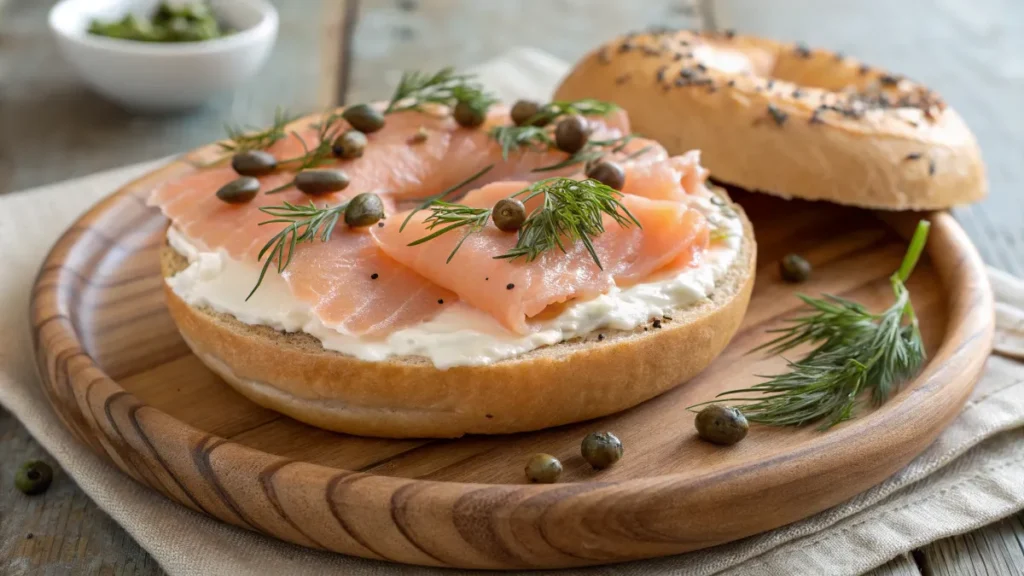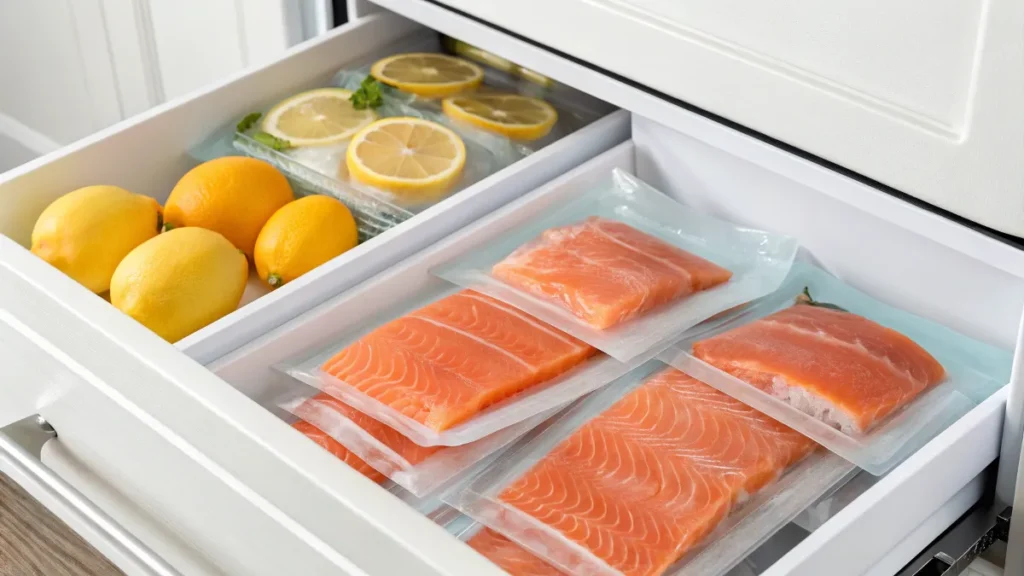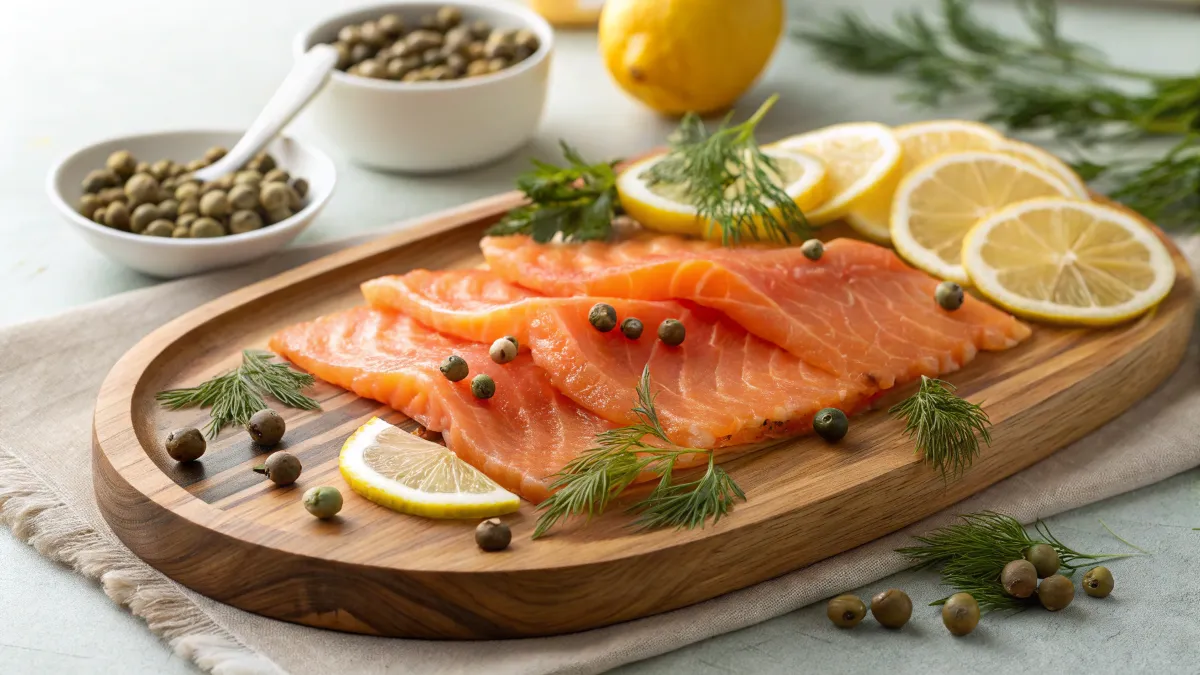Smoked salmon is a timeless delicacy enjoyed worldwide. But not all smoked salmon is the same there’s a distinct difference between cold smoked salmon and hot smoked salmon. This article explores their differences, from preparation techniques to taste and texture, helping you make informed choices for your palate and plate.
Table of Contents
Smoked Salmon
Smoked salmon has been a cherished food for centuries, loved for its distinct flavor and versatility. But what exactly is smoked salmon? Let’s take a closer look.
What is Smoked Salmon?
Smoked salmon is salmon that has been cured and smoked to preserve its rich taste and extend its shelf life. Traditionally, this process involved exposing the fish to salt and smoke, both of which inhibit spoilage and add that characteristic smoky flavor.
There are two main methods of smoking salmon: cold smoking and hot smoking. Each technique creates a unique product with different flavors, textures, and uses.
A Brief History of Smoked Salmon
The origins of smoked salmon date back centuries when communities near water sources needed methods to preserve their catch. Smoking became a practical and flavorful way to ensure the fish stayed fresh for longer.
In regions like Scandinavia, Scotland, and North America, smoked salmon evolved into a culinary tradition. Over time, it gained popularity for its exquisite taste and became a staple in gourmet dishes.
Smoked salmon continues to be loved for its rich nutrients, including omega-3 fatty acids and high-quality protein. Whether served on a bagel or as part of an elegant hors d’oeuvre, it’s a versatile treat.
What is Hot Smoked Salmon?
Hot smoked salmon is a delicious variation of smoked salmon that undergoes a unique smoking process. This method not only enhances its flavor but also creates a distinct texture and mouthfeel that sets it apart from cold smoked salmon.
The Process Behind Hot Smoking
Hot smoking involves cooking the salmon at a higher temperature, usually above 120°F (49°C). The fish is typically cured with salt beforehand, then placed in a smoker where it’s exposed to both heat and flavorful wood smoke. This process fully cooks the salmon, giving it a flaky texture and rich, smoky taste.
The choice of wood, such as alder, hickory, or applewood, adds different flavor profiles to the salmon. For tips on smoking techniques and recipes for hot smoked salmon, you can visit Taste of Home for trusted guides.
Hot Smoked Salmon: A Unique Texture and Flavor
Unlike cold smoked salmon, which has a silky, delicate texture, hot smoked salmon is firmer and flakier. Its bold smoky flavor makes it a popular choice for hearty dishes like pasta, salads, or even on its own as a protein-packed snack.
Hot smoked salmon can also be found in a variety of seasonings, from sweet and tangy glazes to spicy rubs. For recipe inspiration, explore the options on Bon Appétit, which offers innovative ways to enjoy this smoky treat.
Key Differences Between Smoked Salmon and Hot Smoked Salmon
When comparing smoked salmon vs hot smoked salmon, it’s essential to understand their key differences. These variations in preparation, flavor, and texture define their unique characteristics.
Smoking Process: Cold vs. Hot Smoking
Cold smoking involves exposing the salmon to temperatures below 90°F (32°C) over several hours. This technique imparts a smoky flavor without cooking the fish, leaving it silky and raw-like in texture.
Hot smoking, on the other hand, cooks the salmon completely at higher temperatures, resulting in a firm and flaky product. For a step-by-step guide to both processes, check out Food Network, which provides practical tips for home smoking enthusiasts.
Texture and Taste Variations
The texture of cold smoked salmon is buttery and soft, making it ideal for thin slicing and pairing with bagels, cream cheese, or crackers. In contrast, hot smoked salmon is meaty and robust, perfect for flaking into salads or serving warm with grains.
The taste also differs significantly. Cold smoked salmon offers a subtle, delicate smoky flavor, while hot smoked salmon delivers a rich, bold smokiness. You can explore recipes that highlight these flavors on Epicurious.
Nutritional Differences
Both types of salmon are packed with omega-3 fatty acids and high-quality protein. However, the hot smoking process may slightly reduce the fish’s moisture content, affecting the overall calorie and fat levels. For detailed nutritional insights, visit BBC Good Food, where you’ll find valuable tips on choosing healthy smoked salmon options.
Preparation Techniques and Culinary Uses
Smoked salmon, whether cold or hot smoked, offers a range of exciting ways to enhance meals. From simple breakfasts to elegant dinners, its versatility knows no bounds. Let’s explore the preparation methods and culinary delights of both varieties.
How to Prepare Smoked Salmon

Cold smoked salmon is often pre-sliced and ready to eat. It’s best served chilled, making it a popular choice for bagels, cream cheese, and garnishes. For a quick and flavorful breakfast idea, consider adding cold smoked salmon to avocado toast.
Hot smoked salmon, with its firm texture, can be served warm or cold. It’s perfect for recipes like salads, pasta dishes, and even casseroles. If you’re looking for a hearty dinner option, try incorporating hot smoked salmon into a creamy rice bake. For more inspiration, check out this Easy Canned Salmon and Rice Bake Recipe on Charmed Recipes.
Cooking and Serving Ideas for Hot Smoked Salmon
Hot smoked salmon shines in hot dishes. Flake it into scrambled eggs for a smoky breakfast twist or mix it into risotto for a comforting dinner. Its robust flavor pairs wonderfully with roasted vegetables or grain-based salads.
For creative serving ideas, visit Taste of Home and Minimalist Baker, which feature numerous ways to incorporate smoked salmon into your meals.
Best Pairings for Smoked Salmon Dishes
Both types of smoked salmon pair well with fresh, tangy, and creamy flavors. Cold smoked salmon is excellent with dill, capers, and lemon. Hot smoked salmon complements robust flavors like horseradish, mustard, or even a touch of honey.
Health Benefits and Nutritional Insights
Smoked salmon is not only delicious but also packed with nutrients that benefit your health. Whether it’s cold or hot smoked, this fish is a powerhouse of essential vitamins and minerals.
Omega-3 Fatty Acids and Their Importance
Both cold and hot smoked salmon are rich in omega-3 fatty acids, which are vital for heart and brain health. These healthy fats help reduce inflammation and lower the risk of chronic diseases.
For more insights on the nutritional benefits of salmon, explore the resources on BBC Good Food, which provide helpful information about incorporating nutrient-rich foods into your diet.
Calorie and Protein Comparison
When comparing smoked salmon vs hot smoked salmon, it’s worth noting the calorie and protein content. Hot smoked salmon tends to have slightly fewer calories due to the loss of moisture during the smoking process. However, both varieties are excellent sources of high-quality protein, making them ideal for muscle repair and overall health.
Preservative Use in Smoked Salmon Products
Most smoked salmon products contain natural preservatives like salt. However, some brands may add artificial preservatives to extend shelf life. Choosing fresh, minimally processed options ensures you get the best taste and health benefits.
If you’re interested in recipes that highlight the natural flavors of salmon, browse Bon Appétit for ideas that focus on fresh ingredients.
Choosing the Right Option: Smoked Salmon or Hot Smoked Salmon?
Deciding between smoked salmon vs hot smoked salmon can be tricky, especially if you’re unfamiliar with their unique features. The choice largely depends on your taste preferences, culinary plans, and desired texture.
Factors to Consider: Taste, Texture, and Usage
The main difference lies in their taste and texture. Cold smoked salmon is silky, delicate, and mildly smoky. It’s ideal for elegant dishes like lox on a bagel or as a topping for hors d’oeuvres. On the other hand, hot smoked salmon is bold, firm, and flakier. It’s perfect for hearty meals like salads, pasta, or grain bowls.
Your choice also depends on how you plan to serve the salmon. If you’re looking for a ready-to-eat option for cold dishes, cold smoked salmon is the way to go. For cooked recipes, hot smoked salmon offers more versatility and holds up better when reheated.
Popular Preferences Based on Global Cuisine
Different regions have their own smoked salmon preferences. In Scandinavia, cold smoked salmon is often served with dill, mustard, or rye bread. In contrast, hot smoked salmon is popular in North America, frequently paired with barbecue-style sides or incorporated into casseroles.
To explore creative recipes featuring both types, visit Food Network, which offers a wide variety of ideas to suit any occasion.
Price and Availability Considerations
The price of smoked salmon can vary depending on the smoking method, flavoring, and packaging. Cold smoked salmon is often sold in thin slices, making it slightly pricier per pound. Hot smoked salmon, usually sold in chunks or fillets, is more economical if you need larger portions.
How to Store and Handle Smoked Salmon Safely

Proper storage is crucial to ensure the freshness and safety of both cold and hot smoked salmon. Let’s look at some essential tips for handling these delicate products.
Refrigeration and Shelf Life
Both types of smoked salmon should be stored in the refrigerator. Cold smoked salmon typically lasts 1-2 weeks when unopened, while hot smoked salmon has a slightly longer shelf life of 2-3 weeks. Once opened, consume them within a few days to maintain freshness.
How to Freeze Smoked Salmon Without Losing Quality
If you want to extend the shelf life of your smoked salmon, freezing is an excellent option. To freeze cold smoked salmon, wrap it tightly in plastic wrap, then place it in an airtight container or freezer bag. Hot smoked salmon can also be frozen, but its firmer texture helps it hold up better after thawing.
When ready to use, thaw the salmon in the refrigerator overnight for best results. Avoid refreezing, as it can compromise both texture and flavor. For additional storage tips, check out BBC Good Food.
Preventing Contamination and Spoilage
Always store smoked salmon in its original packaging or an airtight container to avoid contamination. Keep it away from strong-smelling foods in the fridge to prevent odor transfer. Regularly check for any signs of spoilage, such as discoloration or an off smell.
Taking these precautions ensures your smoked salmon remains safe and delicious. Whether it’s cold smoked or hot smoked, proper storage can make all the difference.
Cold Smoked Salmon vs. Hot Smoked Salmon (Comparison Table)
To better understand the differences between smoked salmon vs hot smoked salmon, here’s a quick comparison table that highlights their key characteristics:
| Feature | Cold Smoked Salmon | Hot Smoked Salmon |
|---|---|---|
| Smoking Temperature | Below 90°F (32°C) | Above 120°F (49°C) |
| Texture | Silky, smooth | Firm, flaky |
| Flavor Profile | Mild, delicate | Bold, smoky |
| Shelf Life (Refrigerated) | 1-2 weeks | 2-3 weeks |
| Best Uses | Bagels, appetizers | Salads, pasta, standalone dish |
This table simplifies the decision-making process by presenting the differences side-by-side. It can help you choose the right type for your meal or recipe.
For recipes that utilize each type of smoked salmon, visit Bon Appétit or Minimalist Baker for step-by-step guides.
Frequently Asked Questions (FAQs)
To address common queries about smoked salmon vs hot smoked salmon, here are some FAQs with detailed answers:
Is cold-smoked salmon safe to eat?
Yes, cold smoked salmon is safe to eat when prepared and stored properly. It undergoes curing with salt to preserve the fish and reduce harmful bacteria. However, people with weakened immune systems should choose hot smoked salmon, as it’s fully cooked.
Can you cook hot smoked salmon?
Absolutely! Hot smoked salmon is already cooked, but you can use it in various recipes like pasta, casseroles, or scrambled eggs. Heating enhances its bold flavor, making it perfect for warm dishes.
What are the best recipes for smoked salmon?
Both types of smoked salmon are versatile. Cold smoked salmon is excellent for breakfast dishes like bagels or avocado toast. Hot smoked salmon works wonderfully in grain bowls, creamy pastas, or paired with roasted vegetables. For more ideas, explore Food Network for creative recipes.
How is smoked salmon preserved?
Smoked salmon is preserved through a combination of curing (with salt) and smoking. These methods inhibit spoilage and add flavor. To extend its shelf life, store it in a refrigerator or freezer.
Which type of smoked salmon is healthier?
Both types are nutritious and high in omega-3 fatty acids. Hot smoked salmon has slightly fewer calories due to moisture loss during smoking. Choosing between them depends on your taste and dietary needs.
Tips for Buying High-Quality Smoked Salmon
When choosing between smoked salmon vs hot smoked salmon, selecting a high-quality product ensures the best flavor and nutrition.
Read the Labels
Look for products with minimal ingredients. High-quality smoked salmon typically contains salmon, salt, and natural flavorings. Avoid items with artificial preservatives, as they can compromise the taste and nutritional value.
Check for Freshness
Always check the packaging date and ensure the salmon is within its expiration period. Fresh smoked salmon should have a mild aroma and a vibrant color.
Where to Buy Smoked Salmon
You can find premium smoked salmon at local fish markets, gourmet stores, or reputable online retailers. For guidance on incorporating smoked salmon into your meals, explore the creative recipes on Charmed Recipes.
Conclusion: Smoked Salmon or Hot Smoked Salmon: The Choice is Yours!
Both cold smoked and hot smoked salmon have their unique characteristics, making them versatile additions to various dishes. Cold smoked salmon is perfect for light, refreshing meals, while hot smoked salmon shines in heartier, cooked recipes.
When deciding between smoked salmon vs hot smoked salmon, consider your flavor preferences, the dish you’re preparing, and storage requirements. By following the tips and insights in this article, you’ll be well-equipped to enjoy the best of both worlds.
For more creative recipes featuring smoked salmon, check out the delicious ideas on Taste of Home or BBC Good Food.

